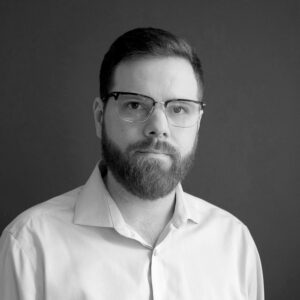Inside the $3 Billion School Security Industry: Companies Market Sophisticated Technology to ‘Harden’ Campuses, but Will It Make Us Safe?
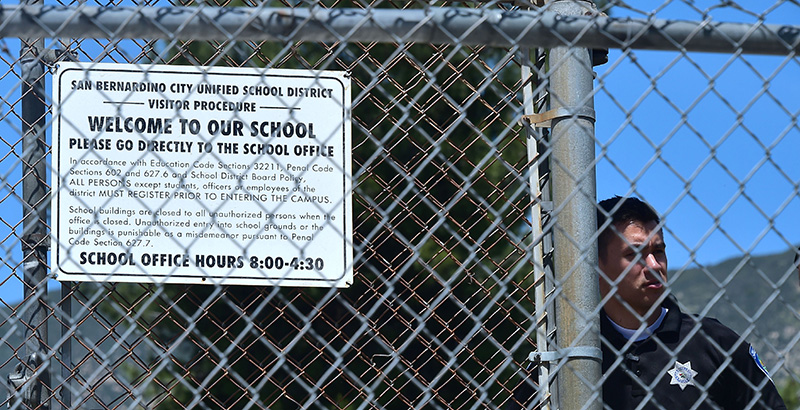
Inside an underground meeting room attached to the U.S. Capitol, past guards and metal detectors, lawmakers and officials from leading security companies discussed a burgeoning threat of mass school shootings and the dire need to “harden” campuses before someone else gets killed.
“If you think this cannot happen to you, I’m here to tell you I used to think the same exact thing,” said Noel Glacer, a Florida-based security professional. The message — belied by the statistical rarity of school shootings — was part cautionary tale, part call to action.
Glacer is no dispassionate observer. In February, his son, Jake, was in a psychology class at Marjory Stoneman Douglas High School when a gunman opened fire, killing 17. Glacer urged people in the room to donate to SOS Parkland, a nonprofit that’s raising money to equip the city’s schools with additional security.
“It was horrible,” he said, recalling the Valentine’s Day shooting. “It can happen to you. It can.”
Glacer spoke at a roundtable in Washington in late June, part of the annual conference of the Security Industry Association, a trade group. Attendees included Trump administration officials, legislators from both parties, security-company executives, and industry lobbyists.
Security officials in the room hawked a range of products that could have been ripped from a James Bond movie: surveillance cameras with facial recognition capability, automated door locks, gunshot detection sensors, and software that scans social media platforms in search of the next shooter. If schools across the country put a larger emphasis on securing their buildings, they said, educators could prevent shootings or, at the very least, mitigate the bloodshed.
Each major school shooting — Columbine, Sandy Hook, Parkland — has added fuel to a multibillion-dollar industry encompassing everything from sophisticated surveillance technology to high-priced consultants to explain it all to anxious educators.
The recent tragedies are pumping new energy — not to mention funds — into strategies to keep children safe, including millions of dollars in federal money from the STOP School Violence Act.
As each tragedy stokes fresh outrage from parents, education leaders say they’re inundated with sales pitches from security companies, each with the same basic message: You could be next.
Such a climate is “ripe for exploitation,” argues Kenneth Trump, president of National School Safety and Security Services, which consults districts on school safety planning. The result, according to many critics, is that the security industry has dominated the policy response to school shootings, drowning out subtler conversations about issues ranging from mental health to gun control in favor of a rush to adopt costly, and largely unproven, methods to harden schools.
“It’s not that they’re villains and they don’t care and they don’t want safe schools — I’m not trying to send that message,” said Trump, who has no relation to the president. “But they’re certainly opportunistic. At the end of the day, they’re looking for new revenue streams.”
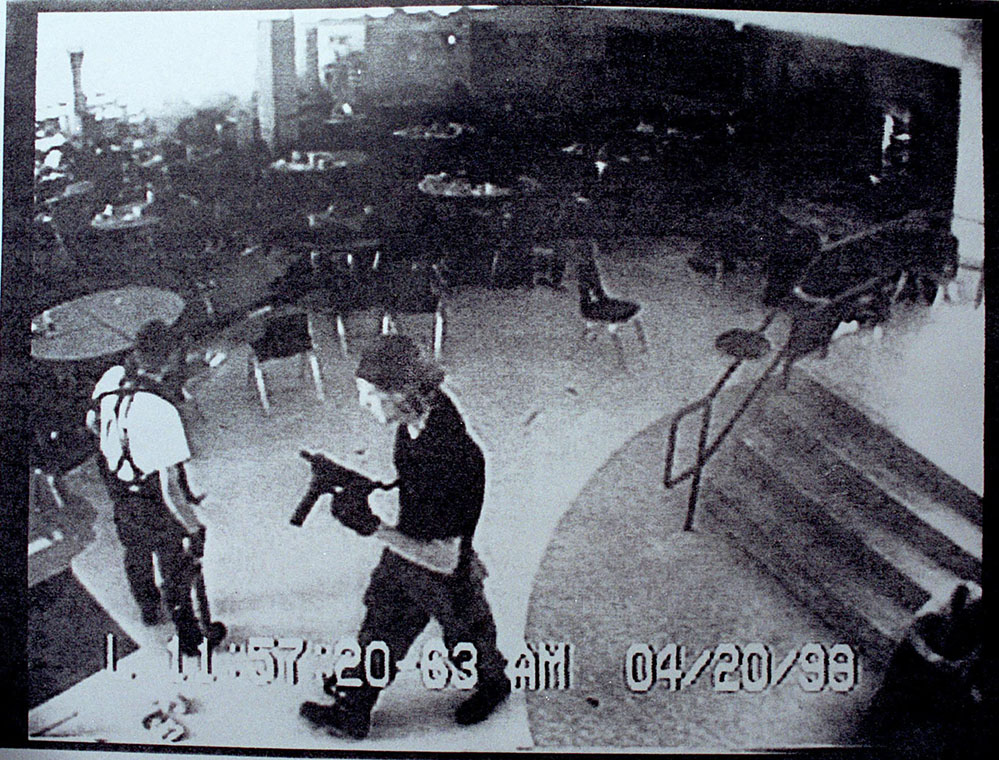
The Columbine ‘Wake-up Call’
It began with Columbine.
Before that, Guy Grace said, security efforts in his Colorado school district centered on kids with spray paint cans, not guns. For Grace, director of security and emergency preparedness at Littleton Public Schools, the shift was instantaneous.
On the morning of April 20, 1999, he was lifting weights at the gym when his pager went off. Two students had walked into Columbine High School in a neighboring school district and killed 15 people, including themselves. After that, his job was never the same.
“It was a complete change, just a wake-up call for us all,” he said. “It certainly has shaped a lot of what we do across the country in regards to school safety.”
Before Columbine, Littleton didn’t have any security cameras at its schools, Grace said. The district has since installed more than a thousand cameras, some with analytics capabilities that can alert authorities to unusual activity, such as someone walking onto school grounds in the middle of the night. The cameras are part of the comprehensive school security equipment the district installed after the community approved a bond in 2013 providing more than $7.5 million for the upgrades. Just last year, he said, a gunshot detection sensor, which can recognize the audio signatures of gunfire, alerted officials when a student committed suicide on a school playground.
The growth in Littleton’s school security infrastructure is mirrored in districts across the country. During the 1999-2000 school year, 19 percent of schools were equipped with security cameras, according to the National Center for Education Statistics. By the 2015-16 school year, 81 percent of schools had video surveillance. The percentage of schools reporting that they control access to their buildings has also spiked, from 75 percent to 94 percent, during the same time period.
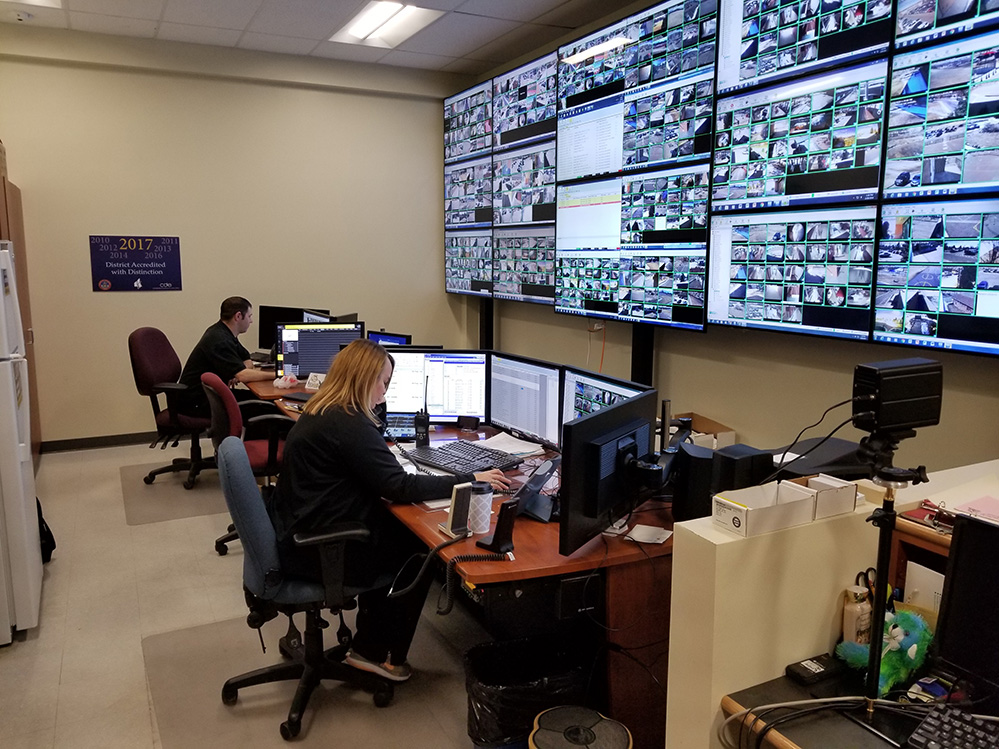
Fear Factor
The surge in school surveillance has been a boon for companies that make and install the products. In 2017, security equipment and services generated $2.7 billion in revenue, according to an analysis by IHS Markit, a market-research firm. Each mass school shooting heightens the profile of school security products, said Jim Dearing, a senior analyst there.
The market analysis underscores what any salesman knows: Anxiety can be good for business.
“For anyone to say, ‘It’s not going to happen here,’ all they’re doing is playing the law of large numbers and assuming that they’re going to get lucky,” said Harry Rhulen, co-founder of Firestorm Solutions, a crisis-and-risk-management firm that contracts with school districts.
To pitch his company’s violence-prevention program, Rhulen laid out a chilling scenario: Every school in America, he said, has students, teachers, or staff members who are “sitting on the fence.” Maybe they’re dealing with mental health issues. Maybe they’re experiencing spousal abuse or are dependent on drugs or alcohol. “Something may push them off the fence.”
The upshot: One of them could become the next shooter, he said, “and there’s just no way to know which school is next.”
Among the company’s school safety recommendations is an anonymous reporting tool, which allows students to report troubling behaviors they observe in peers, and social media monitoring systems that crawl through platforms like Facebook to identify threats.
But is Rhulen framing the danger fairly?
David Ropeik, a consultant on the psychology of risk perception, has written that the odds that a K-12 student will be shot and killed at a public school are roughly 1 in 614 million. According to the most recent federal education statistics, between 1992 and 2015, fewer than 3 percent of murders in which the victims were children and fewer than 1 percent of youth suicides occurred at schools. The data showed that reported incidents of violent crimes in schools has declined over the same time period.
Still, a third of parents say they fear for their child’s safety at school, according to a recent poll by Phi Delta Kappa International, a professional association for educators. That poll found widespread support for school security measures like armed school police and metal detectors.
Marketing Tragedy
Recognizing the heightened concern, officials at the security industry conference seized the moment. Inside the Independence Ballroom at the Grand Hyatt Washington, salesmen touted some of their latest wares: door locks that open with a smartphone app, motion detectors that notify staff before a visitor reaches the building, and cameras that track guests as they walk around campus.
There’s a larger force motivating these new offerings. The school security industry will experience slower growth in the coming years, Dearing of IHS Markit predicts. Since a majority of schools now have surveillance equipment, fewer districts are entering the market for the first time. In response, he said, companies are marketing the next generation of school safety products, like scanners that track license plates in the parking lot and high-security classroom doors.
Salespeople argue, and they hope schools agree, that as older products become obsolete, schools install the newest ones to stay safe. In order to persuade educators, security companies are making in-person sales pitches and building pop-up displays at education conferences. Some companies hold their own events to promote the importance of heavily outfitted campuses.
For example, Axis Communications, a company that sells surveillance cameras and other hardware, hosts school-safety symposiums several times a year in cities across the country. Scott Dunn, the company’s senior director of business development solutions and services, said the symposiums aren’t designed as marketing pitches but rather serve as opportunities to inform educators about the need for security plans and technology to keep kids safe.
But interactions with security companies have left a bad taste in the mouths of some district leaders.
After the Sandy Hook Elementary School shooting in 2012, Connecticut awarded the Newtown district $50 million to build a new, state-of-the-art campus. Now-retired superintendent Joseph Erardi quipped that after the tragedy, he made “dozens of immediate new best friends” from the ranks of security companies looking to get their products inside the school.
“In some cases, they were sincere,” said Erardi, who retired in 2017 and now consults districts on school safety planning. “In other cases, it was all about branding and marketing Newtown.”
Grace, the director of security and emergency preparedness in Littleton, had a similar experience. In 2013, a nightmare unfolded in his district. In a shooting that lasted less than 80 seconds, a senior at Arapahoe High School walked into the school and killed a classmate before taking his own life.
For security companies, Grace’s reality became a sales pitch.
“They start pounding all the school districts across the country and then they say, ‘Don’t be like Arapahoe High School,’” Grace said. “You sit there and go, ‘Who is this idiot? He’s trying to capitalize on a tragedy that we just had in our school district.’ I just despise that with a passion.”
‘How Many More Kids Have to Die?’
As industry leaders sipped cocktails at the security-conference reception, Representative John Rutherford, Republican of Florida, acknowledged he owed a recent legislative success to people in the room. Just weeks before the February shooting in Parkland, Rutherford had introduced the STOP School Violence Act, a law that directs hundreds of millions of dollars over a decade toward school security and will thus be a boon for security companies. (Every year, districts spend far more than that on such companies’ products and services.)
“The STOP School Violence Act could not have gotten across the finish line as quickly as it did without the support of this group, as well as the school safety caucus and the advocacy from the Partner Alliance for Safer Schools,” Rutherford said.
Much of the conference’s discussions around campus security were led by the Secure Schools Alliance and the Partner Alliance for Safer Schools, two advocacy groups that urge schools to take more measures to prevent shootings and other threats. Secure Schools is funded by security companies, and the Partner Alliance is a joint venture of the Security Industry Association and the National Systems Contractors Association, both trade groups. The Partner Alliance and Secure Schools maintain advisory boards staffed largely by officials from security companies; for example, the public affairs director of Allegion, a security company that focuses on door locks and other entry technology, serves on the boards of both groups.
Robert Boyd, executive director of the Secure Schools Alliance, says his group is funded solely by security companies because “they get it.” (He added that the group plans to add officials who represent school police and fire marshals to their board.)
He said leading companies like Allegion aren’t investing in school security efforts to sell more locks. Instead, the company recognizes a dire need.
“They look at it and they say, ‘You know, we understand what happened in Sandy Hook was a facilities failure,’” Boyd said. “Folks in the security industry, we understand how to keep intruders out of a building.”
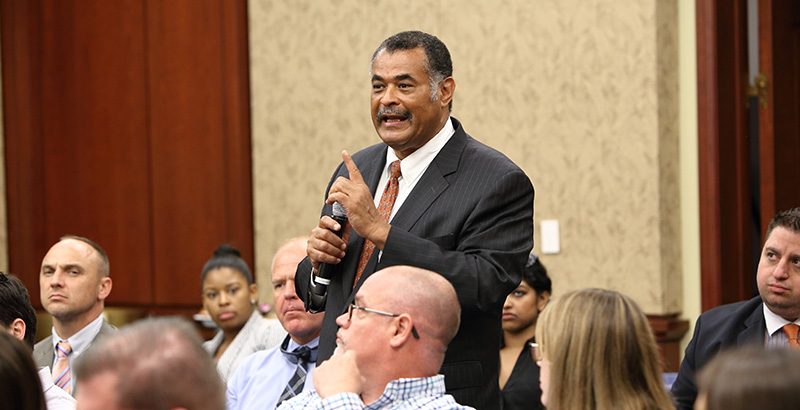
But that’s not to say they don’t make a profit. In 2017, Allegion reported $2.4 billion in net revenue, and Timothy Eckersley, president of Allegion’s Americas region, said school security is a “significant” part of its business.
Beyond the STOP Act, security companies and partner advocacy groups have also worked to ensure that conversations around hardened campuses continue in Washington. In 2016, Rep. Susan Brooks, Republican of Indiana, and Rep. Rick Larsen, Democrat of Washington, teamed up to form the Congressional School Safety Caucus. Brooks acknowledged that the caucus was formed after executives at security companies with offices in her district, including Allegion, urged the move.
In order to advance federal policies like the STOP legislation, Boyd said, advocates with his group “hit the pavement” on Capitol Hill. “You go office to office, staff to staff, committee to committee.”
The group also advocates at the state level for specific school safety laws, including ones that establish security standards (which can require, as more than a dozen states’ do, technology like surveillance systems and bullet-resistant entryways), allot funding for hardware upgrades, and mandate frequent facility assessments. Boyd is also a co-chair of the homeland security task force at the American Legislative Exchange Council, or ALEC, a national nonprofit that drafts state-level legislation for use by conservative legislators across the U.S. After highlighting states with school security laws at the group’s annual meeting earlier this week, he said, he hopes additional state lawmakers get on board.
Trump, the safety consultant, said he is concerned about the influence that security companies, and the advocacy partners they fund, wield over lawmakers.
“While physical security has a piece in the puzzle, the concerning part is when big business in the security industry is trying to single-handedly have laws changed and rewrite codes, which at no coincidence benefit their business interests,” he said.
Boyd pushed back on this argument. He maintains that school security should be decided at the district level but that the state guidelines his association works on help ensure that schools aren’t “throwing money at the problem.”
He said he’s simply frustrated with the level of security deemed acceptable at schools. In the interests of student safety, he’s of the opinion that “school security needs to be a little bit more inconvenient,” like it is in other government buildings such as federal courthouses.
“When you go to that courthouse, if they tell you, ‘Drop your pants,’ you’re going to drop your pants or you’re not getting into the building,” he said. “They’re going to inspect you thoroughly because we’ve had our share of courthouse shootings, and they stopped them. At what point does the collective outrage say, ‘Enough’? How many more kids have to die?”
The State of Research
Indeed, Boyd and others in the security industry say their products save lives. “No shooter has ever breached a locked classroom door,” he said, pointing to the example of the shooting at Sandy Hook.
In fact, the school’s front door was locked, but that didn’t stop the gunman. He shot through a window near the front entrance to get in. In the part of the building where the shooting unfolded, classroom doors only locked with a key — from the outside. More could have been done to protect students, he said.
“If you had a ballistic-graded entrance and you had lockable classroom doors, that death toll comes way down — if he even gets in,” he said.
Superintendents and state schools chiefs acknowledged in interviews that physical security is crucial to maintaining safe schools.
But in some cases, tech-driven school security mechanisms have been plagued by human error. In Parkland, for example, emergency personnel didn’t realize the school’s surveillance cameras were operating on a 20-minute delay, complicating the police response.
In fact, aside from anecdotes, little academic research exists on whether security technology actually works. In 2016, Heather Schwartz, associate director of RAND Education, released a study of school districts that deployed sophisticated security technology. From entry control equipment to video surveillance to violence prediction technology and software that scans students’ social media profiles, she found, independent research was surprisingly scarce on products’ ability to prevent tragedies or mitigate risk. Ironically, when lawmakers approved the STOP Act, they reappropriated funds from a post-Sandy Hook grant program that financed research on school safety.
“I thought it was concerning there was such a lack of evidence about forms of technology that seem to be widely used,” Schwartz said.
Despite the dearth of research, critics say efforts to harden schools are driving attention away from other interventions like mental health screenings, behavioral supports, or even gun control. In fact, some research has found heightened surveillance instills in students a feeling that their schools are unsafe, and that students in schools with several forms of visible surveillance, like cameras and metal detectors, had greater exposure to drugs and fighting.
Meanwhile, civil rights groups and other critics have raised concerns about pervasive surveillance, which is deployed disproportionately to schools that serve high populations of students of color. The American Civil Liberties Union argues that facial recognition technology is “notoriously inaccurate” and could lead to students being punished for offenses they didn’t commit.
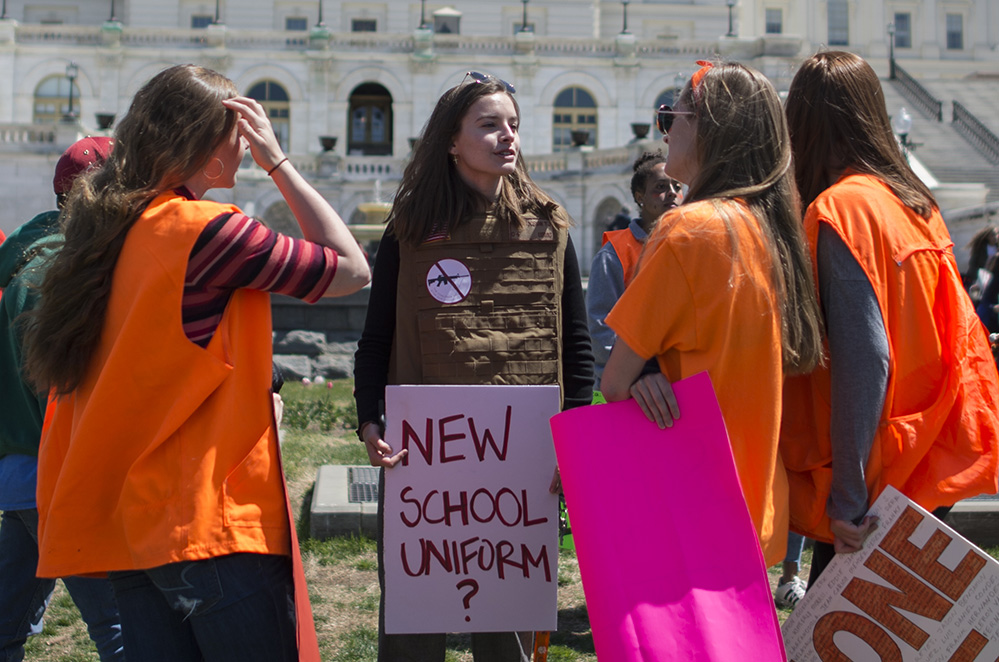
Security as ‘a Way of Life’
As school leaders across the country explore available security options, Dale Marsden, superintendent in San Bernardino, California, said the benefits of hardened schools are clear. But, he added, security equipment has its limits.
Safety efforts in San Bernardino intensified after a shooting at North Park Elementary School last year, when a man went to his estranged wife’s special education classroom, killing her and a student before taking his own life. After the incident, the district sought input from parents, North Park teachers, emergency responders, security companies, and safety consultants that cost the district more than $100,000, Marsden said. The district spent more than $1 million to redesign the school and implement new security measures. Among the upgrades, he said, is a buzzer system that allows access to different parts of the building and a campus entry process that runs background checks on visitors. Nonetheless, he said, there’s no such thing as “absolute safety.”
“If a shooter is intent on coming into a campus and you have a visitor control system, it sounds harsh, but someone can take out the visitor control system,” said Marsden, an Air Force veteran who specialized in security. “Can some of those things slow down or prevent? Yes. Can you have absolute safety? No.”
Although Marsden said cost is a major roadblock for districts considering new security initiatives, Eckersley of Allegion said educators get too “wrapped up about the money.” He pointed to the Partner Alliance’s “tiered” guidelines that encourage districts to start with basic infrastructure and work their way up to the Cadillac of school safety plans. Though the recommendations don’t push specific brands, districts that opt to implement the guidelines would be in for a major monetary investment.
Relying on costs from the recent security upgrades in Littleton, the Partner Alliance estimates it would cost a district about $170,000 per high school to implement the most basic tier, bringing the price tag to an estimated $11 billion for all campuses across the country. For a district to implement the most sophisticated security systems outlined by the group, it’d cost an estimated $540,000 per high school, or nearly $36 billion at all schools nationwide.
Once schools reach that top level — with electronic gates, technology that scans license plates, bullet-resistant glass, and other equipment — a Partner Alliance PowerPoint slide said that “security is no longer a project — it is a way of life.”
Get stories like these delivered straight to your inbox. Sign up for The 74 Newsletter

;)
